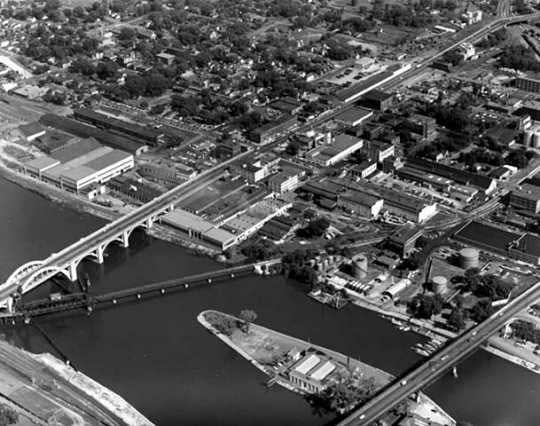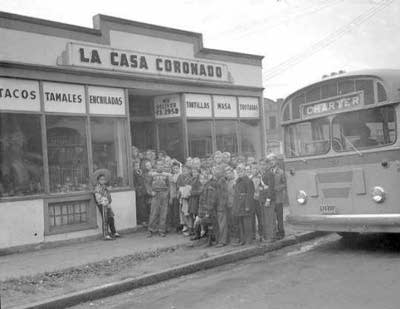Former West Side Flats residents have mixed memories about their old neighborhood
The West Side Flats and Swede Hollow were early centers for new immigrants before they were razed

Go Deeper.
Create an account or log in to save stories.
Like this?
Thanks for liking this story! We have added it to a list of your favorite stories.
Editor’s note: The following story contains a derogatory term.
Augustine “Augie” Garcia was born in St. Paul’s west side in 1946. He lived in the West Side Flats until his family moved in 1959.
By the time the neighborhood was torn down, Mexican immigrants had become one of the largest groups living in the West Side Flats.
Despite the years, the memories of the West Side Flats as a vibrant and multiethnic community remain.
Turn Up Your Support
MPR News helps you turn down the noise and build shared understanding. Turn up your support for this public resource and keep trusted journalism accessible to all.
Garcia is one of several gentlemen who regularly meet on Tuesday mornings at the Sunlight Restaurant in South St. Paul to talk and reminisce. The men are now in their 70s, 80s and 90s, but to look at them, you would be hard-pressed to guess their real ages.
Growing up in the West Side Flats, they knew of each other and decades later they would come together through mutual acquaintances.
“The West Side Flats was a melting pot as far as I was concerned,” Garcia said.
The West Side Flats was also home to other immigrants. Russian Jews began settling there in the 1880s.

He also was quick to point out that he isn’t that Augie Garcia.

The other Augie Garcia, who was also from the West Side Flats, is the man who came to be known as the godfather of Minnesota rock-and-roll.
Augie Garcia died in 1999. But he is perhaps best-remembered for nearly upstaging Elvis Presley. In 1956, Elvis performed at the St. Paul Auditorium and the Augie Garcia Quintet was the opening act. News reports recount that Garcia whipped the crowd into such a frenzy that Elvis’ manager had him pulled off the stage.
Despite the passing years, Nick Arenas, who is in his 90s, still recalls the address where he grew up and the spot of the nearby businesses.
“I lived at 167 Fairfield, I moved three times in the same block. On the corner of Fairfield and Eva was the New Ray Theater. And kitty corner to that was Our Lady of Guadalupe Church. Across the street from the theater was the Coronado Café,” Arenas said.
Arenas still has fond memories of the Neighborhood House. It was founded in 1897 by women from the Mount Zion Temple. It initially opened to help Russian Jewish immigrants. Later it would be a place of assistance for all immigrants. The West Side Flats was its home for its first 65 years.
“They had a woodshop downstairs in the basement of the Neighborhood House. I built my first pair of skis there,” Arenas said.
Garcia said his family lived on State Street before leaving the Flats in 1959. His grandfather lived on Robertson until leaving a couple years later.
“But there was only two houses on the block — my grandfather’s house and the people who lived across the street,” Garcia said.
He also recalled going to Mass at Our Lady of Guadalupe on Sundays; and then stopping at the Jewish bakery. They’d buy horns and bagels and then go to his grandfather’s to eat.
“That’s where I also learned how to eat rye bread and pumpernickel. But I did like bagels. And I was having bagels at a young age where most of the time people my age didn’t know what a bagel was,” Garcia said.
Frank Cruz, who is in his late 80s, also grew up and lived in the West Side Flats until they were forced to move. Cruz acknowledges some of the not-so-good memories. He doesn’t shy away from talking about the discrimination Mexicans faced.
Cruz recalled being 5, 6, 7 years old and how he and his siblings would head across the Robert Street bridge with a wagon in tow. They’d go to the warehouses to collect scrap metal. He said that on their way back down, people from the upper part of town would call them names.
“They’d always be criticizing us to go back to Mexico, ‘wetbacks,’ this and that, always had different name calling. But like you say, sticks and stones will break your bones, but words aren’t going to hurt. But they do stick to your head,” Cruz said.
The West Side Flats was not the only place where Mexican immigrants and other newcomers settled.
Swede Hollow — as its name implies — was settled by Swedish immigrants in the 1850s.
Both Swede Hollow and the West Side Flats welcomed immigrant newcomers during the same time period.
Lena Norrman, a senior lecturer in Swedish at the University of Minnesota, has studied Swede Hollow. She said not much is written about Swede Hollow because people were working hard to simply survive. And they didn’t have time to write down their memories, Norrman said.
“It was difficult to find work at the time, especially for the first generation not knowing any English and trying to get into the labor market. So these are not the people who would write down the history,” she said.

The homes that made up Swede Hollow were shacks. There were no sewage lines. Outhouses were built over the creek.
The early immigrants who settled in Swede Hollow had one goal, said Norrman.
“The game was to move up to come to the street level. Because if you made it to the street level, then you could disappear into Minneapolis. So, if you started at the very bottom of the creek, that was the worst place ever to live,” Norrman said.
In its nearly 100 years welcoming immigrants, Swede Hollow never had a sewer system. Citing unsanitary conditions, the city of St. Paul ordered the settlement to be burned down in 1956.

Back across the river, residents of the West Side Flats would also face displacement.
The community was built in a low-lying area that was prone to flooding. The city of St. Paul would eventually use this as a reason to demolish the neighborhood.
A devastating flood hit the area in 1952. In 1956, the city announced it would build Riverview Industrial Park.
By 1962 the last families had left the West Side Flats. And to protect that industrial park, the city built a flood wall.
Cruz has bitter memories about how much — or rather how little — the city paid families for their homes.
“They cheated you. The most people were getting was $6,000, 7,000 for their home,” Cruz said.
Cruz said his brother fought that low-ball price. He recalled how his brother would see houses like his. He’d knock on the door and ask the homeowner the house’s value. He’d also take a photo. His brother eventually went to court, Cruz said.
“The judge looks at him. He said, ‘How much do you want to give you?’ $6,000. And the judge looked at him he says no, you give him $13,000,” Cruz said.
There was a reason it wasn’t higher, he said.
“And the only reason he didn't go more because the city was already saying the reason they're chasing us out of here,” Cruz said. “It's because we live in wetland. It was all wet and all of a sudden 100 years later it's wetland.”

Vicki Adame covers Minnesota’s Latino communities for MPR News via Report for America, a national service program that places journalists into local newsrooms to report on undercovered issues and communities.






